
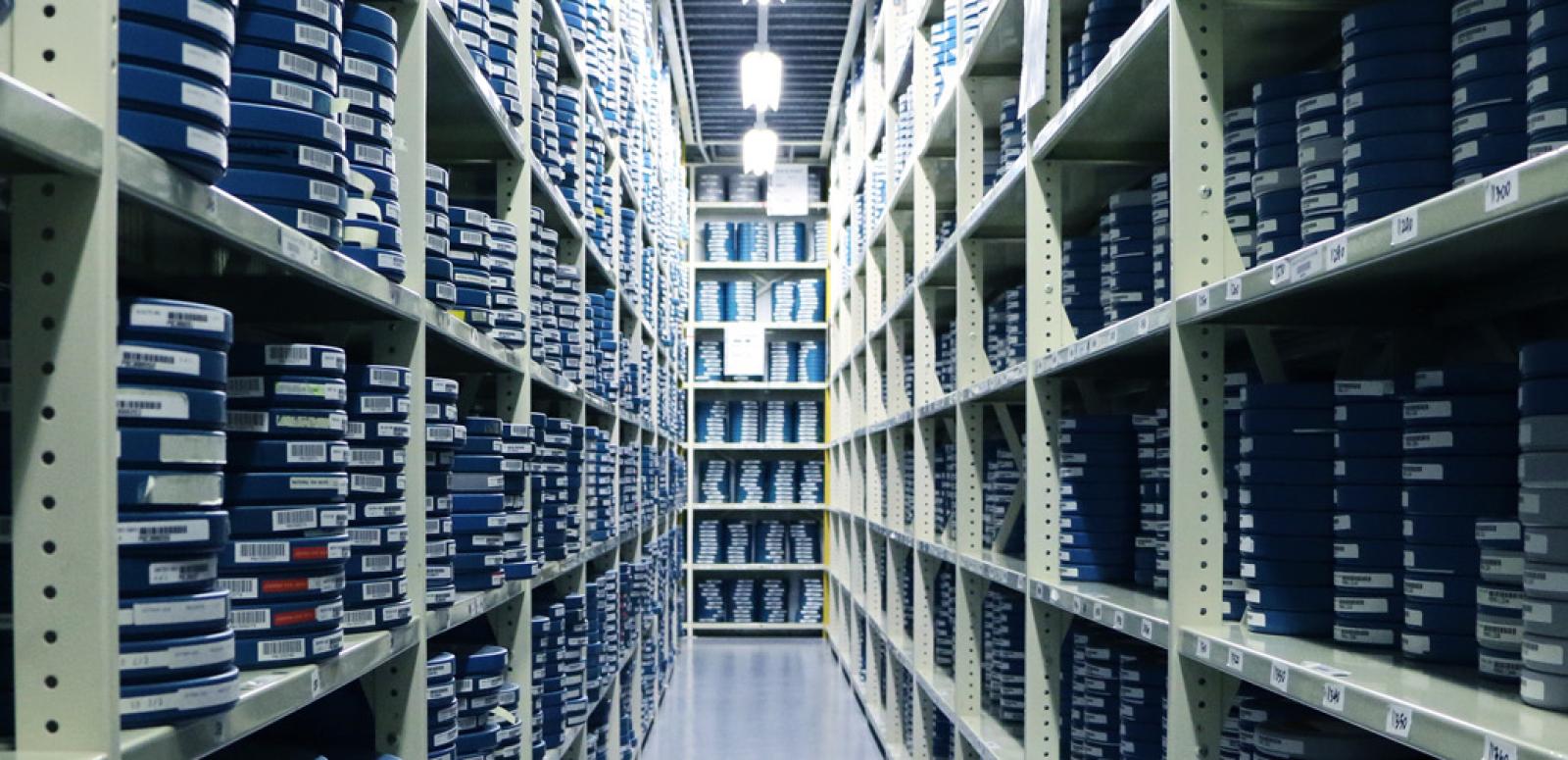
Annual Report 2015-16
Purpose 2: PRESERVING THE COLLECTION
Preservation ensures permanent access to the national audiovisual collection, while accessioning and cataloguing the collection aids its discoverability. We store the collection in accordance with recommended international standards (passive preservation), and actively preserve it through both analogue copying and digitisation. This financial year we preserved 13,195 titles (see figure 4), an increase of 2,895 titles preserved from the previous financial year.
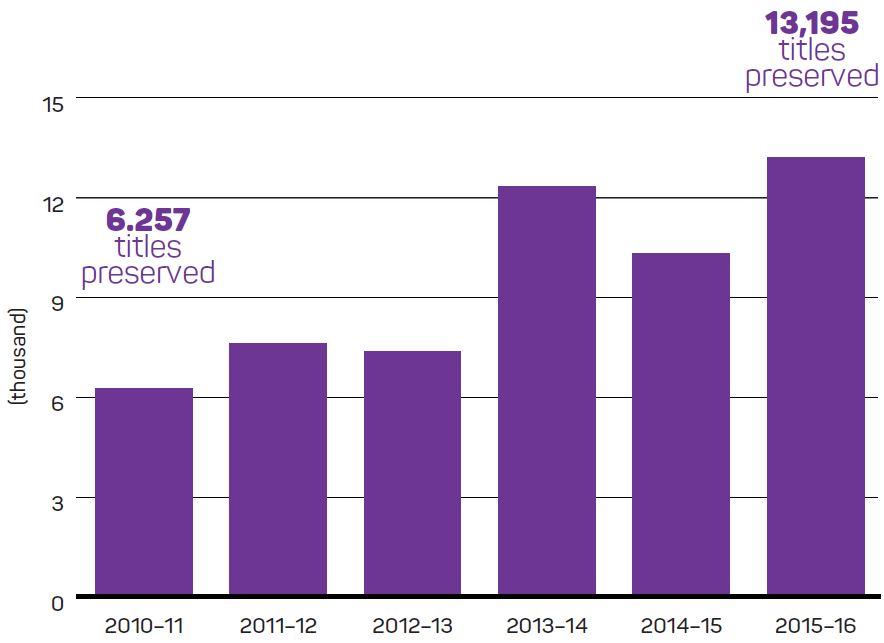
Figure 4: Preservation of audiovisual titles, 2010–11 to 2015–16
Case Study 1:
Film restoration goes digital
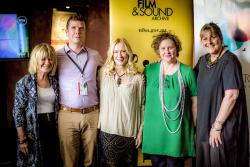
The NFSA has a long tradition of restoring films. Thanks to the work of our experts and industry partners over the decades, audiences have been able to discover titles such as The Story of the Kelly Gang (1906), The Sentimental Bloke (1919) and the iconic Wake in Fright (1971). These films would have been lost had it not been for our restoration efforts.
Over a period of 10 years from 2000 to 2011, new film prints were produced through our Kodak/Atlab and Deluxe/Kodak photochemical programs. The result was the restoration of 75 iconic titles that have since enjoyed a rejuvenated appreciation by a new generation of admiring audiences.
In the digital world in which we now live, digital film restoration was the next logical step.
Our NFSA Restores program delivers two very important outcomes to the national collection:
- The first is the creation of premium 4K preservation masters files for image and wav files for sound, which will be used for current and future copying.
- The second outcome is the delivery of restored full 2K cinema quality and HD files for exhibition and broadcast, noting that only a very few cinemas can now screen 35mm film prints in Australia.
The NFSA Restores Advisory Panel provides advice about which titles should be restored. The panel consists of NFSA Ambassador, Margaret Pomeranz; Director and CEO of the Australian Centre for the Moving Image (ACMI), Katrina Sedgwick; and historian, filmmaker and distributor, Andrew Pike.


The panel’s final selection of a film is a balance of culturally significant titles and those whose original materials call for conservation and restoration of:
- popular films that resonated with the public and critics, and others that are yet to be discovered by a mainstream audience
- features and documentaries
- early works by renowned filmmakers or actors, and key titles that represent a particular time in Australia’s film history.
Appropriate source material in our national collection is identified, examined and selected. Ideally, this source material is the 35mm original picture negative for picture and the 35mm final mix magnetic film for sound.
Our Audiovisual Conservators and Audio Services team then assess and provide condition reports and recommendations of potential source picture and sound components. Each report outlines the extent of any damage/deterioration and confirms that all components are complete and the same version. This involves highly trained specialists winding through the film looking for decomposition, shrinkage, buckle and wave, perforation damage and scratches.
Necessary repairs are then completed. Conservation work may be required on the sound component as well, as was the case with the final mix magnetic film for Storm Boy (Henri Safran, 1976). This required moisture to be extracted to enable safe passage of the film through the audio digitisation process. Only then can Audio Services begin their work of restoring the sound.
Once the picture component has been determined as viable, a one-light telecine is made so that the restored audio wav files can be married to the vision to check picture and sound synchronisation.
If source materials held in the collection are not matching, we may need to do an extensive international search for the correct components. For example, the sound source for the Starstruck (Gillian Armstrong, 1982) restoration was found in the United States. Components are then prepared for shipment to our restoration partner, Frame Set and Match.
Specialised restoration software tools are used to digitally restore the film, carefully removing dirt and artefacts that have built up over time, as well as removing all kinds of scratches. Colour grading is done scene by scene to restore the colours in the film back to those seen at the film’s first release. Grading and cleaning are a mixture of automated and manual processes, and the older the components are, the more manual attention they will need.
After the initial cleaning and grading, work-in-progress screenings are scheduled for the director, producer and cinematographer to provide comments on the work.
This restoration process delivers digital files that will take their place in the national collection along with the original analogue materials from which they were derived. They will be migrated every 3 years, ensuring high-quality digital preservation and delivery as the technology continues to evolve.
Results: PRESERVING the Collection

Pathway 2.1.1 PASSIVE PRESERVATION
In 2014 we adopted the Time Weighted Preservation Index standard created by the Image Permanence Institute at Rochester University, USA. This measure provides the means to understand the preservation quality of a storage environment. The value of it is that it can integrate changing temperature and relative humidity conditions and deliver one number that reflects the average collection lifespan.
The target figure (275 years) was set in error and has been corrected to 230 for future years.
| Criterion source: Program 1.1, 2015–16 Portfolio Budget Statements page 376, 2015–16 Corporate Plan page 7 |
| Strategic Priority 1: A ‘living’ archive – for everyone |

Pathway 2.1.2 RESTORED AND REMASTERED FILMS
Our new restoration program, NFSA Restores, was launched in October 2015. The program uses the best available original picture and sound components to create digitally restored masters for preservation purposes, and digital cinema prints for screening.
NFSA Restores titles launched or underway in 2015–16 included:
- Howling III: The Marsupials (Philippe Mora, 1987)
- Starstruck (Gillian Armstrong, 1982)
- Storm Boy (Henri Safran, 1976)
- Bliss (Ray Lawrence, 1985)
- Proof (Jocelyn Moorhouse, 1991)
- The Odd Angry Shot (Tom Jeffrey, 1979).
For more information about NFSA Restores, see the case study on page 21.
| Criterion source: 2015–16 Corporate Plan page 7 |
| Strategic Priority 1: A ‘living’ archive – for everyone |

Pathway 2.2.1 PRESERVATION ACTIVITY
Building capacity for efficient digital preservation using in-house resources is an ongoing priority for the NFSA. In 2015–16 we implemented a number of infrastructure and system improvements that resulted in higher output through our preservation programs. These upgrades included:
- new audio studio hardware that delivers more flexible operations and faster processing of audio material
- video edit suite upgrades that dramatically reduce render and transfer time
- upgraded equipment and facilities for our paper and still imaging team that reduce set-up time and enable increased production
- new systems supporting an increased focus on film digitisation in our film preservation area.
Finding an effective balance between analogue and digital moving image operations has seen a reduction in the very labour-intensive photochemical film preservation process. This has increased the resources available for film digitisation.
See figure 4 (page 20) for information about the number of titles preserved from 2010–11 to 2015–16.
| Criterion source: Program 1.1, 2015–16 Portfolio Budget Statements page 376, 2015–16 Corporate Plan page 7–8 |
| Strategic Priority 2: Developing leadership in the digital environment |

Pathway 2.2.2 PRESERVATION RATE
Priority has been given to assessing our capacity for digitising magnetic materials in the first instance. This is due to the impending obsolescence of replay technology that will result in a global loss of capability for digitisation of this type of material within the next 10 years.
The analysis indicates a shortfall of about 60% in our capacity to digitise collection material on magnetic media (based on resources current at the time of the analysis). This also includes consideration of our expected continuous improvement in capacity and capability in the short- to mid-term.
| Criterion source: 2015–16 Corporate Plan page 8 |
| Strategic Priority 2: Developing leadership in the digital environment |
CASE STUDY 2:
MAGNETIC MEDIA ON A DEADLINE
“There is now consensus among audiovisual archives internationally that we will not be able to support large-scale digitisation of magnetic media in the very near future. Tape that is not digitised by 2025 will, in most cases, be lost forever.” Deadline 2025: Collections at Risk
In 2015–16 we took a leadership role in addressing the pressing need to digitise Australia’s audiovisual heritage. On 27 October 2015, to mark UNESCO’s World Day for Audiovisual Heritage, our CEO Michael Loebenstein launched a policy paper, Deadline 2025, which highlighted the fact that much of our audiovisual heritage will be lost within the next 10 years if it is not digitised. Thousands of items in our collection consist of magnetic tape which, it is estimated, will be permanently lost by 2025 due to deterioration and technological obsolescence.
Magnetic tape technology encompasses a wide range of formats across video and audio. Some of the most popular formats are music cassette tapes, videotape, 8-track tape and betacam. We estimate that we currently hold over 60,000 television programs on videotape, 80,000 radio programs on audiotape, and thousands of master tapes of iconic Australian music performers – all of which will be lost without digitisation.
Deadline 2025 called for the development of a national framework for the digitisation of audiovisual collections and for the targeted, quality digitisation of magnetic tape formats by 2025.
In response to the paper’s release, in early 2016 we brought the NFSA together with a number of related organisations to begin the development of this national framework. The other organisations included the Australian Institute of Aboriginal and Torres Strait Islander Studies, the Australian Broadcasting Corporation, the Australian War Memorial, the National Archives of Australia, and the National Library of Australia. All of these agencies have audiovisual collections and are facing similar pressures to the NFSA.
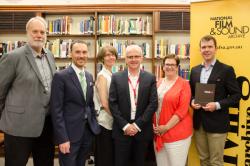
During 2016 we worked together to develop a national framework which will be released in October 2016. The framework will outline a uniform approach to digitising our audiovisual history, help us to prioritise the materials to be digitised, and explain how this will be done. This is a first – and critical – step in building a case to support the large-scale digitisation of our audiovisual collections so that they are available for decades to come.

Pathway 2.2.3 LARGE-SCALE DIGITISATION OF AUDIO AND VIDEOTAPE COLLECTIONS
The Chair of the NFSA Board is working with the Chairs of other national collecting institutions on an ongoing basis to scope potential avenues for obtaining additional funding to deal with the major shared collection digitisation challenge. In addition, we initiated a working group to address the practical issues of effectively exploiting such funds as and when they become available. The working group comprises the NFSA, the Australian Institute of Aboriginal and Torres Strait Islander Studies, the Australian Broadcasting Corporation, the Australian War Memorial, the National Archives of Australia, and the National Library of Australia.
The working group has commissioned a consultancy to develop a National Framework for the Digitisation of At-Risk Audiovisual Collections. This consultancy will address:
- the need for digitisation, including the scope of the collections to be digitised
- a high-level approach to prioritising the digitisation of collections
- a governance model enabling the efficient and accountable delivery of digitisation outcomes
- a high-level cost estimate based on agency costings and comparative market rates
- recommendations on a best practice model to increase the discoverability of digitised holdings.
See the case study on page 25 for more information about Deadline 2025 and collections at risk.
| Criterion source: 2015–16 Corporate Plan page 7 |
| Strategic Priority 2: Developing leadership in the digital environment |

Pathway 2.2.4 SECTOR LEADERSHIP AND ENGAGEMENT
On 27 October 2015 around 100 participants attended the Digital Directions: Archiving into the Future symposium to celebrate UNESCO’s World Audiovisual Heritage Day. The 2015 theme for the day was ‘Collections at risk’, focusing on the need to preserve audiovisual items as an integral part of national identity.
We brought together a variety of speakers from the collections and academic sectors, including a keynote presentation by Associate Professor Martin Hadlow (University of Queensland and Deputy Chair of the Australian Commission for UNESCO) on archival experiences in post-conflict zones. Cynthia Coleman (New South Wales Library) gave a presentation on the large-scale digitisation of archival collections, and Stephanie Boyle (Australian War Memorial) discussed the impact of changing technology in the Australian War Memorial’s home movies collection.
To accompany the symposium our CEO, Michael Loebenstein, released a discussion paper, Deadline 2025: collections at risk, which highlighted the impending deterioration of audiovisual collection material due to physical deterioration and technical obsolescence. In 2016–17 we will continue to explore the topic of digitisation through our thought-leadership symposia series.
On 4–5 December 2015 we were also the partner and host organisation for the Australian Media Traditions conference, Sightings and Soundings. As part of that conference we hosted a panel session, Archives live! Being relevant and nimble in the digital age. Presentations came from across Australia’s academic sector, and also included international keynote speakers, David Hendy (University of Sussex, UK) and Hans-Ulrich Wagner (Hans-Bredow Institut, Germany). Our CEO and a number of our staff contributed to papers and panel discussions for the conference, and a choral performance led by Tobias Cole was staged to demonstrate the technical capability of our audio and technical teams.
| Criterion source: 2015–16 Corporate Plan pages 7–8 |
| Strategic Priority 2: Developing leadership in the digital environment |

Pathway 2.2.5 DIGITISATION
The 1.9% difference between the target and the result this year reflects substantial analogue collection accessioning in this period, and some adjustments to the counting method. We will review the target for future years because of the change to the counting method.
| Criterion source: Program 1.1, 2015–16 Portfolio Budget Statements page 377, cross-agency performance indicator |

Pathway 2.4.1 FIRST PEOPLE’S CULTURAL PRESERVATION STRATEGY
We worked closely with both IRCA and AIATSIS this financial year to deliver key outcomes, including the establishment of our Indigenous Remote Archival Fellowship Program. The inaugural fellows arrived at our Acton Headquarters on
11 March 2016 for a week of workshops and training. They also visited our Sydney office, the Australian Film, Television and Radio School and AIATSIS.
Also in March 2016, we hosted two additional Remote Archival Fellows: Shaun Angeles, from the Strehlow Research Centre (Alice Springs), and Sherika Nulgit, from the Mowanjum Art Centre (Derby). While at the NFSA, the fellows had the opportunity to share information and learn about archival and preservation practices in relation to audiovisual collections. The purpose of the fellowship is to build participants’ skills and the capacity within their communities to preserve cultural material. See the case study on page 33 for more information.
During the year there was ongoing and regular communication between AIATSIS and our Executive and staff on matters such as the preservation of audiovisual materials, Indigenous employment, training and capacity-building.
| Criterion source: 2015–16 Corporate Plan pages 8–9 |
| Strategic Priority 4: Indigenous connections |
ANALYSIS OF PERFORMANCE:
PRESERVING the Collection
Preservation targets have generally been met or surpassed this financial year. Our passive preservation storage measures (using the Time Weighted Preservation Index approach) are being refined and clarified to deliver effective, consistent reporting outcomes.
The 2016 discussion paper Deadline 2025 identifies the major challenge to meet the need for digitisation of the large volume of relevant magnetic tape media by 2025, when equipment and skills are expected to massively reduce and disappear. We are collaborating with relevant cultural agencies through a number of initiatives to seek substantial additional government funding to support this archival imperative.
Our focus on magnetic media digitisation is demonstrated by the very high figures achieved in audio and video preservation. The lower figures for film preservation reflect the complexity of film-based preservation activity. Preservation of a single title in our collection may require multiple items to be produced.
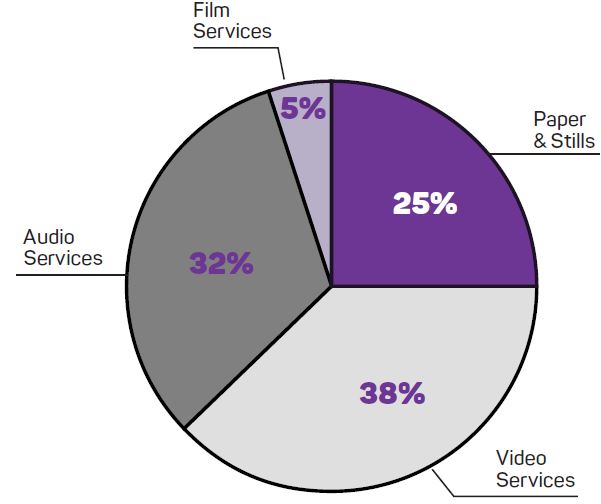
Items made in preservation programs 2015–16
The Indigenous Remote Archival Fellowship, delivered in partnership with IRCA, is a targeted program to build capacity for cultural maintenance in Aboriginal and Torres Strait Islander communities. Cultural workers receive hands-on training in archival practice and digital asset management from our experts, allowing us to share our knowledge and contribute to the reconciliation agenda.
Training and skills development for our staff in digital production technologies and capabilities have been enhanced by significant equipment upgrades. The balance of analogue and digital collection preservation support continues as we maintain both format approaches according to archival principles.
Key achievements
- Focus within the preservation team this year has seen substantial progress in internal high-quality digitisation options and practices.
- Preservation staff were commissioned to provide practical film handling training for staff of the Prasad Film Company in India over a two-week consultancy. This reflects the high regard in which NFSA expertise is held and a practical commercial approach to diversifying our service opportunities.
- Upgrades to our audio studios resulted in more efficient workflows and increased capacity for digitising and restoring our audio collections.
Challenges
- We need to source sufficient additional funding to effectively manage the priority digitisation of original magnetic tape holdings within the next decade.
- There needs to be a shift from traditional format-based preservation workflow to a production model that is scalable and flexible enough to allow us to reassign significant resources to specific projects or initiatives. At the same time, we should outsource low-risk and low-skill bulk work to the private sector or other agencies wherever reasonable and cost efficient.
- We need to continue to make the transition from primarily photochemical film preservation work to motion-picture film scanning at an increased scale.
The National Film and Sound Archive of Australia acknowledges Australia’s Aboriginal and Torres Strait Islander peoples as the Traditional Custodians of the land on which we work and live and gives respect to their Elders both past and present.